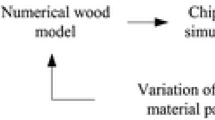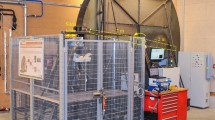Abstract
The aim of this study was to determine the cutting force and specific cutting resistance of modified beech wood (Bendywood, DMDHEU and Lignamon) and, based on experimental results, to calculate the fracture parameters for cutting in axial–perpendicular direction of these modified materials and to compare with native beech wood. In the conventional approaches, cutting force and cutting power in sawing processes of wood are generally calculated based on the specific cutting resistance, which is a function of many factors. A major deficit of these conventional methods is that they are not focusing on the physical and mechanical properties of wood. The influence of these factors is only taken into account by the coefficient of the tree species. In this work, predictions of the newly developed model for the circular sawing machine are presented. Thanks to this modern approach, it was possible to determine fracture toughness and shear yield strength of native beech wood and modified beech wood using experimental results, without performing complex fracture tests. Based on the experiments performed, it can be concluded that modifications have a partial degradation effect on wood properties. The fracture toughness and shear yield strength of the modified materials is not dependent on the density, but rather on the internal structure, extent of the degradation of the cell wall and the type of modification



Similar content being viewed by others
References
Afanasev PS (1961) Derevoobrabatyvayuschie stanki (Woodworking machinery), Moskva
Agapov AI (1983) Dinamika processa pilenija drevesiny na lesopiĺnych ramach (in Russian: Dynamics of wood sawing on frame sawing machines). Kirovskij Politechničeskij Institut Izdanije GGU, Goŕkij
Atkins AG (2003) Modelling metal cutting using modern ductile fracture mechanics: quantitative explanations for some longstanding problems. Int J Mech Sci 45(2):373–396
Atkins AG (2005) Toughness and cutting: a new way of simultaneously determining ductile fracture toughness and strength. Eng Fracture Mech 72:849–860
Atkins AG (2009) The science and engineering of cutting. The mechanics and process of separating, scratching and puncturing biomaterials, metals and non-metals. Butterworth-Heinemann is an imprint of Elsevier, Oxford
Atkins AG, Vincent JFV (1984) An instrumented microtome for improved histological sections and the measurement of fracture toughness. J Mater Sci Lett 3:310–312. https://doi.org/10.1007/BF00729381
Axelsson BOM, Lundberg AS, Grönlund JA (1993) Studies of the main force at and near cutting edge. Holz Roh Werkst 51(1):43–48
Blackman BRK, Hoult TR, Patel Y, Williams JG (2013) Tool sharpness as a factor in machining tests to determine toughness. Eng Fract Mech 101:47–58. https://doi.org/10.1016/j.engfracmech.2012.09.020
Blažek Z (2005) Mechanical properties of compressed plasticized wood. Bachelor thesis, Mendel University in Brno
Böllinghaus T, Byrne G, Cherpakov BI, Chlebus E, Cross CE, Denkena B, Dilthey U, Hatsuzawa T, Herfurth K, Herold H et al (2009) Machining processes, (part 7–3 of chapter: manufacturing engineering). In: Grote K-H, Antonsson EK (eds) Springer handbook of mechanical engineering. Springer, Würzburg, pp 609–656
Bollmus S (2011) Biologische und technologische Eigenschaften von Buchenholz nach einer Modifizierung mit 1,3-dimethylol-4,5-dihydroxyethyleneurea (DMDHEU) [Biological and technological properties of beech wood after modification with 1.3-dimethylol-4.5-dihydroxyethylurea (DMDHEU)]. Dissertation, University of Goettingen
Bollmus S, Dieste A, Militz H, Rademacher P (2009) Properties of modified beechwood. Forst und Holz 64(7/8):30–34
Brischke C, Zimmer K, Ulvcrona T, Bollmus S, Welzbacher CR, Thomsen O (2012) The impact of various modification processes on the structural integrity of wood. In: The sixth European conference on wood modification, pp 91–98
Csanády E, Magoss E (2013) Mechanics of wood machining. Springer, Berlin
Derham BR, Singh T, Militz H (2017) Commercialisation of DMDHEU Modified Wood in Australasia. The International Research Group on Wood Protection, IRG/WP/17-40772
Emmerich L, Bollmus S, Militz H (2017) Wood modification with DMDHEU (1.3-dimethylol-4.5-dihydroxyethyleneurea)—State of the art, recent research activities and future perspectives. Wood Mater Sci Eng 14(1):3–18. https://doi.org/10.1080/17480272.2017.1417907
Fischer R (2004) Micro processes at cutting edge—some basics of machining wood. In: Proceedings of the 2nd international symposium on wood machining, Vienna, Austria, pp 191–202
Hlásková L, Orlowski KA, Kopecký Z, Jedinák M (2015) Sawing processes as a way of determining fracture toughness and shear yield stresses of wood. BioRes 10(3):5381–5394
Hlásková L, Orlowski K, Kopecký Z, Sviták M, Ochrymiuk T (2018) Fracture toughness and shear yield strength determination for two selected species of central European provenance. BioRes 13(3):6171–6186. https://doi.org/10.15376/biores.13.3.6171-6186
Hlásková L, Kopecký Z, Solař A, Patočka Z (2019) Cutting test as a source of fracture toughness and shear yield strength for axial-perpendicular model of wood cutting. Wood Fiber Sci 51(1):58–68. https://doi.org/10.22382/wfs-2019-006
Holan J, Merenda L (2008) Selected mechanical properties of modified beech wood. Acta univ agric et silvic Mendel Brun 1:245–250
Kalnins AJ, Darzins TA, Jukna AD, Berzins GV (1967) Physical mechanical properties with ammonia chemically plasticized wood. Holztechnologie 8(1):23–28
Kivimaa E (1950) The cutting force in woodworking. Report no. 18. The State Institute of Technical Research, Helsinki, Finland
Kowaluk G, Dziurka D, Beer P, Sinn G, Tschegg S (2004) Influence of particleboards production parameters on work of fracture and work of chips formation during cutting. Electron J Polish Agric Univ Poznań 7(1):1
Kopecký Z, Hlásková L, Orlowski K (2014) An innovative approach to prediction energetic effects of wood cutting process with circular-saw blades. Wood Res-Slovakia 59(5):827–834
Krause A (2006) Holzmodifizierung mit N-Methylolvernetzern [Wood modification with cross-linking N-methylol compounds]. Dissertation, University of Goettingen
Krause A, Jones D, van der Zee M, Militz H (2003) Interlace treatment—wood modification with N-methylol compounds. In: van Acker J, Hill C (eds) Proceedings of the ECWM1—first European conference on wood modification. Ghent University, Belgium, 3–4 April 2003, pp 317–328
Krause A, Militz H (2009) Process for improving the durability, dimensional stability and surface hardness of a wood body. US Patent 7,595,116 B2, United States Patent and Trademark Office, Alexandria, VA, USA, p 5
Krenke T, Frybort S, Müller U (2017) Determining cutting force parameters by applying a system function. Mach Sci Technol. https://doi.org/10.1080/10910344.2017.1284563
Laternser R, Gänser H, Taenzer L, Hartmaier A (2003) Chip formation in cellular materials. J Eng Mater Technol 125(1):44–49
Lisičan J (1996) Theory and wood technology. Zvolen, Matcentrum
Mamiński MŁ, Trzepałka A, Auriga R, H’Ng PS, Chin KL (2018) Physical and mechanical properties of thin high density fiberboard bonded with 1,3-dimethylol-4,5-dihydroxyethyleneurea (DMDHEU). J Adhes. https://doi.org/10.1080/00218464.2018.1500280
Militz H (1993) Treatment of timber with water soluble dimethylol resins to improve their dimensional stability and durability. Wood Sci Technol. https://doi.org/10.1007/BF00192221
Orlicz T (1988) Obróbka drewna narzędziami tnącymi. (Wood processing with cutting tools). Warszawa: Skrypty SGGW-AR w Warszawie, Wydawnictwo SGGW-AR, Warszawa (in Polish)
Orlowski K (2007) Experimental studies on specific cutting resistance while cutting with narrow-kerf saws. Adv Manuf Sci Technol 31(1):49–63
Orlowski KA, Atkins A (2007) Determination of the cutting power of the sawing process using both preliminary sawing data and modern fracture mechanics. In: Proceeding on the third international symposium on wood machining. Fracture mechanics and micromechanics of wood and wood composites with regard to wood machining, May 21–23, Lausanne, Switzerland, pp 171–174
Orlowski KA, Pałubicki B (2009) Recent progress in research on the cutting process of wood. A review COST action E35 2004–2008: wood machining-micromechanics and fracture. Holzforschung 63(2):181–185
Orlowski K, Ochrymiuk T, Atkins A, Chuchala D (2013) Application of fracture mechanics for energetic effects predictions while wood sawing. Wood Sci Technol 47(5):949–963
Orlowski KA, Ochrymiuk T, Sandak J, Sandak A (2017) Estimation of fracture toughness and shear yield stress of orthotropic materials in cutting with rotating tools. Eng Fract Mech 178:433–444
Pařil P, Brabec M, Maňák O, Rousek R, Rademacher P, Čermák P, Dejmal A (2014) Comparison of selected physical and mechanical properties of densified beech wood plasticized by ammonia and saturated steam. Eur J Wood Prod 72(5):583–591
Porankiewicz B, Bermúdez JC, Tanaka C (2007) Cutting forces by peripheral cutting of low density wood species. BioResources 2(4):671–681
Rademacher P, Báder M, Németh R, Klímek P (2017) European co-operation in wood research from native wood to engineered materials: Part 3: engineered hybrid wood-based products. Pro Ligno 13(4):361–372
Scholz F, Duss M, Hasslinger R, Ratnasingam J (2009) Integrated model for prediction of cutting forces. In: Proceedings of the 19th international wood machining seminar. 21–23 October, 2009, Nanjing Forestry University, Nanjing, China, pp 183–190
Stojčev A (1979) Lignamon - zušlechtěné dřevo: Výroba, vlastnosti a použití. (Lignamon—treated wood: production, properties and uses), 1st edition. Praha, SNTL (in Czech)
Troppová E, Tippner J, Hrčka R, Halachan P (2013) Quasi-stationary measurements of lignamon thermal properties. BioResources 8(4):6288–6296
Urban J (2013) Ohýbací dřevo. (Bendywood). World Wide Web www.ohybacidrevo.cz. Accessed 19 Mar 2014
Veselý P, Kopecký Z, Hejmal Z, Pokorny P (2012) Diagnostics of circular sawblade vibration by displacement sensors. Drvna Industrija 63(2):81–86. https://doi.org/10.5552/drind.2012.1130
Wang H, Chang L, Ye L, Williams JG (2015) On the toughness measurement for ductile polymers by orthogonal cutting. Eng Fract Mech 149:276–286. https://doi.org/10.1016/j.engfracmech.2015.06.067
Williams JG (1998) Friction and plasticity effects in wedge splitting and cutting fracture tests. J Mater Sci 33(22):5351–5357
Williams JG, Patel Y, Blackman BRK (2010) A fracture mechanics analysis of cutting and machining. Eng Fract Mech 77(2):293–308
Xie Y, Krause A, Militz H, Turkulin H, Richter K, Mai C (2007) Effect of treatments with 1,3-dimethylol-4,5-dihydroxyethyleneurea (DMDHEU) on tensile properties of wood. Holzforschung 61(1):43–50. https://doi.org/10.1515/HF.2007.008
Acknowledgements
This article is based on research sponsored by the Internal Grant Agency FFWT of Mendel University in Brno. The authors are grateful for support of project: Analysis of cutting forces from point of view fracture mechanics in quasi-orthogonal CNC milling and cutting by circular saw-blade (Grant IGA no. LDF_TP_2019008).
Author information
Authors and Affiliations
Corresponding author
Ethics declarations
Conflict of interest
On behalf of all authors, the corresponding author states that there is no conflict of interest.
Additional information
Publisher's Note
Springer Nature remains neutral with regard to jurisdictional claims in published maps and institutional affiliations.
Rights and permissions
About this article
Cite this article
Hlásková, L., Kopecký, Z. & Novák, V. Influence of wood modification on cutting force, specific cutting resistance and fracture parameters during the sawing process using circular sawing machine. Eur. J. Wood Prod. 78, 1173–1182 (2020). https://doi.org/10.1007/s00107-020-01581-2
Received:
Published:
Issue Date:
DOI: https://doi.org/10.1007/s00107-020-01581-2




